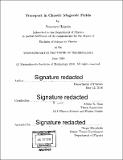| dc.contributor.advisor | Abhay K. Ram. | en_US |
| dc.contributor.author | Holguin, Francisco, Jr | en_US |
| dc.contributor.other | Massachusetts Institute of Technology. Department of Physics. | en_US |
| dc.date.accessioned | 2016-12-05T19:55:26Z | |
| dc.date.available | 2016-12-05T19:55:26Z | |
| dc.date.copyright | 2016 | en_US |
| dc.date.issued | 2016 | en_US |
| dc.identifier.uri | http://hdl.handle.net/1721.1/105624 | |
| dc.description | Thesis: S.B., Massachusetts Institute of Technology, Department of Physics, 2016. | en_US |
| dc.description | Cataloged from PDF version of thesis. | en_US |
| dc.description | Includes bibliographical references (pages 51-52). | en_US |
| dc.description.abstract | Many astrophysical environments are thought to contain force-free magnetic fields. The sine field is an example of a force-free, helical magnetic field, whose field lines are chaotic over the entire space. In this thesis, we examine the transport properties of magnetic field lines and particles in three related systems: the sine field, the sine field superimposed with a constant background field, and a time varying sine field. We also compare results with the Arnold-Beltrami-Childress (ABC) field. In the time-independent sine field, we find that particles exhibit chaotic motion, shown by a non-zero distribution of Lyapunov exponents (LE). While for low energies the asymtotic LE do not depend on initial particle position or angle with respect to the local magnetic field line, these parameters are important for higher energies. On larger time scales, we find that an ensemble of particles undergoes close to normal diffusion for low energies and superdiffusion for high energies. This contrasts with the superdiffusion found at low energies with the ABC field. Additionally, we find that adding a constant magnetic introduces a saturation time scale in the cross field diffusion. The saturatino can be both temporary or more long term. We find that the low energy particle motion is ballistic. In contrast, for higher energies we find widely varying behavior, ranging from superdiffusion to normal diffusion. At the highest energies though, the behavior becomes uniformly superdiffusive. Futhermore, we introduce a simple sinusoidal time variation into the sine field. We find that in the pure sine field, the particle energy experiences subdiffusion throughout all the time scales. With the constant field added, there is only energization at long timescales, and although not completely conclusive, it looks to eventually undergo normal diffusion in energy. | en_US |
| dc.description.statementofresponsibility | by Francisco Holguin. | en_US |
| dc.format.extent | 52 pages | en_US |
| dc.language.iso | eng | en_US |
| dc.publisher | Massachusetts Institute of Technology | en_US |
| dc.rights | M.I.T. theses are protected by copyright. They may be viewed from this source for any purpose, but reproduction or distribution in any format is prohibited without written permission. See provided URL for inquiries about permission. | en_US |
| dc.rights.uri | http://dspace.mit.edu/handle/1721.1/7582 | en_US |
| dc.subject | Physics. | en_US |
| dc.title | Transport in chaotic magnetic fields | en_US |
| dc.type | Thesis | en_US |
| dc.description.degree | S.B. | en_US |
| dc.contributor.department | Massachusetts Institute of Technology. Department of Physics | |
| dc.identifier.oclc | 962929555 | en_US |
